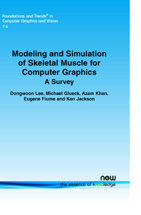Modeling and Simulation of Skeletal Muscle for Computer Graphics: A Survey
By Dongwoon Lee, Autodesk Research, Canada and University of Toronto, Canada, dwlee@cs.toronto.edu | Michael Glueck, Autodesk Research, Canada, Michael.Glueck@autodesk.com | Azam Khan, Autodesk Research, Canada, Azam.Khan@autodesk.com | Eugene Fiume, University of Toronto, Canada, elf@dgp.toronto.edu | Ken Jackson, University of Toronto, Canada, krj@cs.toronto.edu
Abstract
Muscles provide physiological functions to drive body movement and anatomically characterize body shape, making them a crucial component of modeling animated human figures. Substantial effort has been devoted to developing computational models of muscles for the purpose of increasing realism and accuracy in computer graphics and biomechanics. We survey various approaches to model and simulate muscles both morphologically and functionally. Modeling the realistic morphology of muscle requires that muscle deformation be accurately depicted. To this end, several methodologies are presented, including geometrically-based, physically-based, and data-driven approaches. On the other hand, the simulation of physiological muscle functions aims to identify the biomechanical controls responsible for realistic human motion. Estimating these muscle controls has been pursued through static and dynamic simulations. We review and discuss all these approaches, and conclude with suggestions for future research.
Modeling and Simulation of Skeletal Muscle For Computer Graphics
Muscles provide physiological functions to drive body movement and anatomically characterize body shape, making them a crucial component of modeling animated human figures. Substantial effort has been devoted to developing computational models of muscles for the purpose of increasing realism and accuracy in computer graphics and biomechanics.
This short book surveys various approaches to model and simulate muscles both morphologically and functionally. Modeling the realistic morphology of muscle requires that muscle deformation be accurately depicted. To this end, several methodologies are presented, including geometrically-based, physically-based, and data-driven approaches. On the other hand, the simulation of physiological muscle functions aims to identify the biomechanical controls responsible for realistic human motion. Estimating these muscle controls has been pursued through static and dynamic simulations.
Modeling and Simulation of Skeletal Muscle For Computer Graphics: A Survey starts with a brief introduction to anatomical and biomechanical descriptions of muscle, which have been considered in most applications. It goes on to examine various approaches proposed to model muscle deformation and then we addresses muscle control problems and presents related simulation models to solve them. It concludes with a discussion of possible approaches to bridge the efforts of the biomechanical and graphics research communities, working towards a unified model.
